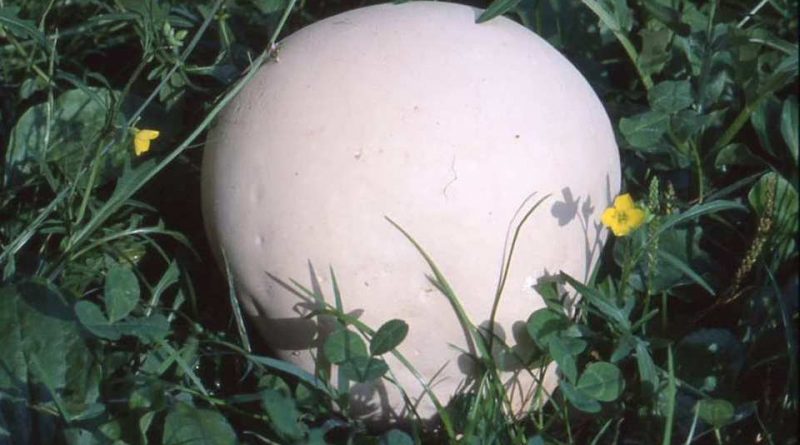Calvatia gigantea
Calvatia gigantea
The Giant puffball (Calvatia gigantea (Batsch) Lloyd, 1904) is a fungus belonging to the family Agaricaceae which can reach considerable size.
Systematics –
From the systematic point of view it belongs to the Eukaryota Domain, Kingdom Fungi, Basidiomycota Division, Class Agaricomycetes, Order Agaricales, Family Agaricaceae and then to the Genus Calvatia and to the species C. gigantea.
Etymology –
The term Calvatia comes from cálvus, bald: fungus that resembles a bald skull. The specific gigantea epithet comes from the Greek γιγάνειος gigánteios, gigantic: for the size, even in a relative sense, compared to other congeners.
Geographic Distribution and Habitat –
The larger or giant vescia normally grows in meadows and mountain pastures amidst the grass of gardens, parks and uncultivated places; we can find it, up to about 3,000 meters of altitude. The giant vescia can be found throughout Italy both in summer and winter.
Recognition –
The Calvatia gigantea is recognized for its fruiting body Subgloboso, round, of 10-50 cm of diameter, with the external part (esoperidio) smooth, fragile, whitish, fleeting; the inner part (endoperidium) is instead fragile, whitish or gray-yellowish, when it clashes up the gleba. The meat is white in young mushrooms, to become pulverulent and greenish-yellow in mature specimens; It has a strong, fungal smell, which is not appreciated by everyone. The taste is however pleasant, typically fungal. At microscopy, the spores are globular or roundish, briefly apicolated, warty, brown-tobacco in bulk, 3-5.5 x 3-5 μm.
Cultivation –
The vescia maggiore is not among the cultivated mushrooms or at least of interest in this sense.
Uses and Traditions –
Calvatia gigantea is one of the most remarkable mushrooms. Specimens up to 20-25 kg and 1 m in diameter were found.
Due to these characteristics, the giant Vesx is a very sought after species of particular value. The internal pulp of the vescia maggiore takes the name of gleba and is edible until its color is white. As it matures, it becomes brown and takes on a dusty consistency. So it is good when young, when the meat (gleba) is still firm and white. For this reason it should be grasped when it feels hard and firm to the touch. This means that its pulp is still white and is therefore suitable for consumption.
Once ripe, the larger vescia explodes, releasing a dark powder in the air that contains the spores for reproduction. Because of this peculiarity in the Brescian dialect, the bladders are called scoreze de luf.
They are synonyms: Bovista gigantea (Batsch) Gray, 1821; Calvatia gigantea (Batsch) G. Cunn., 1926; Globaria gigantea (Batsch) Quél, 1873; Langermannia gigantea (Batsch) Rostk., 1839
Lasiosphaera gigantea (Batsch) F. Šmarda, 1958 and Lycoperdon giganteum Batsch.
Preparation Mode –
The vescia maggiore lends itself well to being eaten cut into slices on the plate, or breaded but can be consumed in many ways. It also lends itself to being eaten raw in salads. For this preparation take the vescia and cut it into slices. Then add a little ‘salt, a little’ lemon and parsley. After a couple of hours it can be consumed.
To prepare the excellent steaks of the vescia major proceed as follows: cut the vescia slices from a thickness of one centimeter. Add salt and leave to rest for at least 20 minutes to remove a little water. Separately, take a bowl and beat a whole egg. Then take the slices of vescia and pass them in the egg beaten first and in the corn flour afterwards. Make sure that the flour adheres well to the surface of the mushroom that must be completely covered with flour. When you have breaded all the slices, dip them in hot oil until lightly browned. Drain and place in a plate with absorbent paper in the bottom. To be consumed warm.
Guido Bissanti
Sources
– Wikipedia, the free encyclopedia.
– Cetto B., 2008. Real mushrooms, Saturnia, Trento.
– Pignatti S., 1982. Flora of Italy, Edagricole, Bologna.
– Conti F., Abbate G., Alessandrini A., Blasi C. (edited by), 2005. An annotated checklist of the Italian vascular flora, Palombi Editore.
Warning: Pharmaceutical applications and alimurgical uses are indicated for informational purposes only and do not in any way represent a medical prescription; there is therefore no liability for their use for curative, aesthetic or food purposes.


